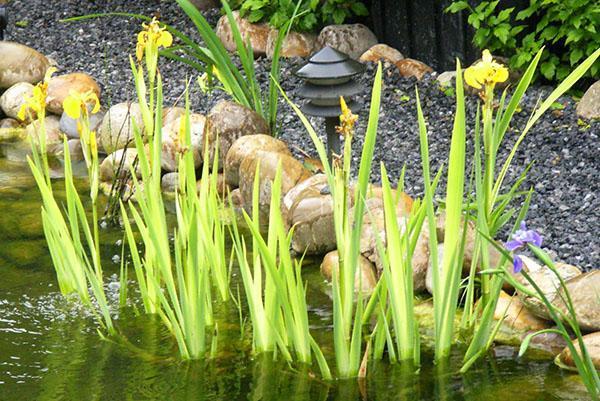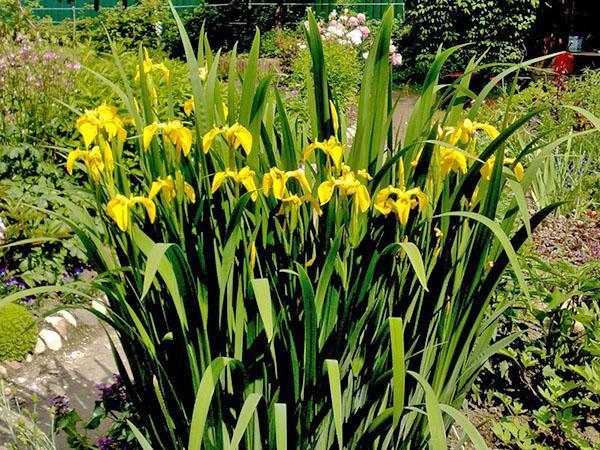Spring and autumn planting of irises in open ground
 Incredibly beautiful in the garden or in the flowerbed look from perennial flowers exactly irises, planting and care in the open field which does not require too much effort. You can plant flowers both in spring and autumn two weeks after the end of flowering.
Incredibly beautiful in the garden or in the flowerbed look from perennial flowers exactly irises, planting and care in the open field which does not require too much effort. You can plant flowers both in spring and autumn two weeks after the end of flowering.
Varieties of irises
There are more than two hundred varieties of the "northern orchid", as flower growers often call irises. The most popular species that grow everywhere are marsh, Japanese and Dutch irises, which are planted and nurtured in the open field mainly in early spring. After planting, the flowers do not require additional watering or feeding. The only thing that needs to be done in a timely manner is to remove fading leaves and fading buds.

 Plants are planted mainly around ponds, pools, lakes. At the same time, flowers get along well on dry soil, feeding on microelements from it, without requiring additional watering.
Plants are planted mainly around ponds, pools, lakes. At the same time, flowers get along well on dry soil, feeding on microelements from it, without requiring additional watering.
 Japanese irises do not have any aroma, reach a height of about 80-100 centimeters, have inflorescences up to 25 centimeters in diameter. This type of plant is planted mainly in soil with low acidity, which does not contain lime. In watering, Japanese irises are most whimsical during the flowering period, when moderate humidity is required.
Japanese irises do not have any aroma, reach a height of about 80-100 centimeters, have inflorescences up to 25 centimeters in diameter. This type of plant is planted mainly in soil with low acidity, which does not contain lime. In watering, Japanese irises are most whimsical during the flowering period, when moderate humidity is required.
 Dutch irises or bulbous are the most popular in the middle zone of the Russian Federation, where the climate is moderate, and the post office has sufficient acidity. Watering is required in moderation, depending on the weather. At the same time, flowering occurs when the air temperature is stably kept within 20-25 degrees Celsius, regardless of the moisture content of the soil.
Dutch irises or bulbous are the most popular in the middle zone of the Russian Federation, where the climate is moderate, and the post office has sufficient acidity. Watering is required in moderation, depending on the weather. At the same time, flowering occurs when the air temperature is stably kept within 20-25 degrees Celsius, regardless of the moisture content of the soil.
Planting irises in the ground in Siberia or in the northern regions is carried out not earlier than May, since earlier Japanese bulbs can freeze or rot.
Spring landing
 Planting irises in the spring in the ground is carried out after preliminary soil preparation. The selected plot of land is carefully dug up, fertilized with a small amount of manure or other natural fertilizer... If non-Japanese irises are planted, then additional chalk can be added to the ground - swamp, Dutch and bearded species feed on limestone.
Planting irises in the spring in the ground is carried out after preliminary soil preparation. The selected plot of land is carefully dug up, fertilized with a small amount of manure or other natural fertilizer... If non-Japanese irises are planted, then additional chalk can be added to the ground - swamp, Dutch and bearded species feed on limestone.
 Prepared bulbs (Dutch varieties) have developed rhizomes, which are treated with an antifungal solution and then dried for several hours. Holes for plants are dug 5-7 centimeters deep, sprinkled with sand. The bulbs are planted in holes at a distance of 10 centimeters from each other. They are not pressed strongly, so as not to spoil the rhizomes, they are sprinkled loosely with earth and sand.
Prepared bulbs (Dutch varieties) have developed rhizomes, which are treated with an antifungal solution and then dried for several hours. Holes for plants are dug 5-7 centimeters deep, sprinkled with sand. The bulbs are planted in holes at a distance of 10 centimeters from each other. They are not pressed strongly, so as not to spoil the rhizomes, they are sprinkled loosely with earth and sand.
Immediately after planting, a little watering is required so that the soil "lightens up".
After that, for two to three weeks, the plants are not watered at all. Then, as necessary, fade or dry leaves are removed using a pruner or a sharp knife.
Autumn landing
 Planting irises in the ground in the fall is carried out only after preliminary preparation of the bulbs. When the plants have faded (usually in mid or late June), they are dug out, washed in warm water with a weak solution of potassium permanganate and dried. Green leaves are not cut, but plaited together, and then removed to a dry place until autumn.
Planting irises in the ground in the fall is carried out only after preliminary preparation of the bulbs. When the plants have faded (usually in mid or late June), they are dug out, washed in warm water with a weak solution of potassium permanganate and dried. Green leaves are not cut, but plaited together, and then removed to a dry place until autumn.
 In the fall, the dried stems are removed, leaving only the bulbs, which are treated with an antifungal compound. The holes are dug at a depth of no more than five centimeters at a distance of 7-12 centimeters from each other. The remains of the stems should not be above the ground, otherwise there is a risk of freezing the entire bulb in winter. After planting, the soil is not watered.
In the fall, the dried stems are removed, leaving only the bulbs, which are treated with an antifungal compound. The holes are dug at a depth of no more than five centimeters at a distance of 7-12 centimeters from each other. The remains of the stems should not be above the ground, otherwise there is a risk of freezing the entire bulb in winter. After planting, the soil is not watered.
The optimal time for disembarkation is the first half of September, when the air temperature does not drop below 17 degrees Celsius.
Care before wintering
 In general, irises require minimal maintenance in the open field - rare or moderate wateringremoving old leaves and inflorescences. However, they need to be thoroughly prepared for wintering, especially if the plants are planted in the fall. After planting, the holes are covered with the paws of a spruce or other coniferous plant. The use of dense covering synthetic or artificial material is not recommended - under it the earth will melt, and the bulbs rot throughout the winter. With the first snow, it is recommended to sprinkle a flower bed with irises as tightly as possible. The first shoots appear almost immediately after the snow melts in the spring - in March-April.
In general, irises require minimal maintenance in the open field - rare or moderate wateringremoving old leaves and inflorescences. However, they need to be thoroughly prepared for wintering, especially if the plants are planted in the fall. After planting, the holes are covered with the paws of a spruce or other coniferous plant. The use of dense covering synthetic or artificial material is not recommended - under it the earth will melt, and the bulbs rot throughout the winter. With the first snow, it is recommended to sprinkle a flower bed with irises as tightly as possible. The first shoots appear almost immediately after the snow melts in the spring - in March-April.
The most unpretentious species to care for
 The Dutch iris varieties are among the most unpretentious. You don't even have to dig them out after the flowering is over. Green leaves will delight the eye until winter. Then you can simply cut them to the very base and cover the flower bed with them for the winter. The spring photo of irises in the open field above clearly shows how quickly the Dutch species bloom at the optimal temperature. Melted snow moistens the soil well, so there is no need to water the plants additionally until flowering.
The Dutch iris varieties are among the most unpretentious. You don't even have to dig them out after the flowering is over. Green leaves will delight the eye until winter. Then you can simply cut them to the very base and cover the flower bed with them for the winter. The spring photo of irises in the open field above clearly shows how quickly the Dutch species bloom at the optimal temperature. Melted snow moistens the soil well, so there is no need to water the plants additionally until flowering.
The flowering period is 4-6 weeks, after which the inflorescences can be removed.
Beneficial features
Irises are unique plants that absorb all bacteria and harmful microelements from the soil. They feed on them. That is why it is recommended to replant flowers to a new place every four years. On the old flower bed, you can grow other, more whimsical plants and even fruit and vegetable crops - the soil for them will be disinfected.
In the new place, the irises are again taken to work to absorb bacteria and harmful microelements. It is recommended to fertilize it with manure a year before planting in a new place, and immediately before planting with organic garden fertilizers. However, Dutch varieties take root well without such preparation. The root system of irises is well developed, therefore, when digging out the bulbs, you need to be extremely careful not to damage the "ball" of roots.
Read also the article:hosta - planting and care in the open field!